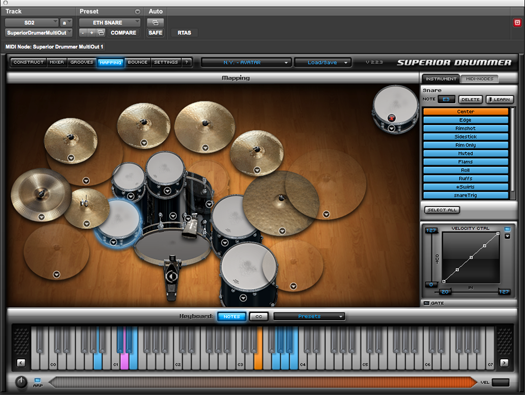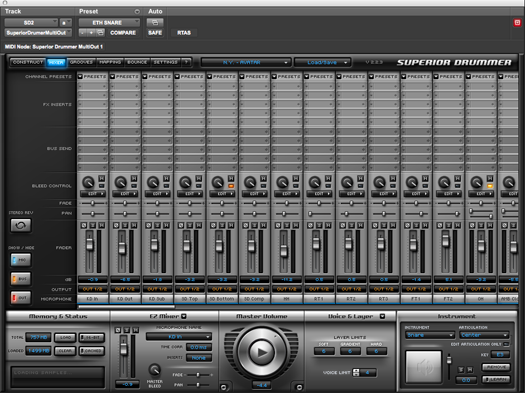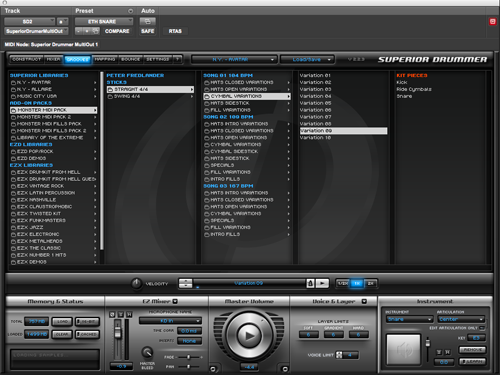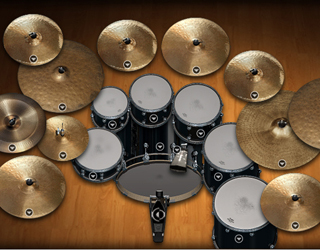Review: Toontrack Superior Drummer 2.0 by Zach McNees
PARK SLOPE, BROOKLYN: In his eponymous autobiography, Slash recollects a story about legendary mix engineer Bob Clearmountain who’d been originally hired to mix the Guns N’ Roses recordings that became the Illusions albums. Slash recalls that he had discovered a notebook where Clearmountain “had notated all of the drum samples he planned to mix in over Matt’s drum tracks…he’d brought in samples that would change Matt’s sound drastically. We showed it to Matt who had no idea and he wasn’t too pleased at all.”
Because each hit was essentially the same exact sample repeated endlessly, drum sampling technology during its infancy in the 1990’s significantly altered the sound of the instruments recorded on tape – creating a robotic, clunky sound. Today, the quality and detail of drum samples available has changed all that, allowing for seamless blending of the original drums with variable, natural sounding multi-track samples.
So while the idea of drum sampling was heresy in the early 90’s, today many drummers assume that their drum sounds can and will be augmented with high quality samples to enhance the overall sound.
Today, there are a great deal of high quality drum sampling software platforms and audio packs available to engineers and producers. At the head of the class is Toontrack who has revolutionized drum sampling with the Superior Drummer software engine. Employing multi-hit and multitrack capabilities, Superior Drummer is by far the most detailed and comprehensive platform I’ve come across for creating, replacing or augmenting acoustic drums and percussion.
TECH SPECS
Superior Drummer 2.0 is available in RTAS, VST and Audio Units formats at 32-bit and 64-bit for both PC and MAC. Superior Drummer 2.0 comes bundled with the NYC Vol.1 Avatar recording studio pack and is available for $349. A great deal of available hard drive space is recommended as full installers can run upwards of 25GB.
WHAT IT DOES
Superior Drummer 2.0 (or SD2) is a full production multitrack drum-sampling platform. SD2 utilizes thousands of drum and cymbal hits corresponding to different MIDI velocities to create a detailed yet user-friendly system for engineers and producers to create and supplement acoustic drums. Each session sold as an SDX pack for SD2 was recorded in a world-class studio with top tier engineers and drummers. For the included Avatar Pack, Toontrack employed Grammy-winning engineer and producer Neil Dorfsman as well as engineer Pat Thrall and drummer Nir Z to shape the sounds.
THE INTERFACE
SD2’s interface is a veritable Starship Enterprise of controls and displays. In standard view, the construct window features a graphical display of a drum kit and cymbals corresponding to the available instruments. Sections for Instrument, Envelope, Pitch, Volume, EZ mixer and Memory & Status as well as drop downs for tool settings and library access provide a wealth of controls for working with the different sounds that SD2 has to offer. Other panels within SD2 provide controls for the full DAW style Mixer, Grooves, Mapping, Bouncing and internal settings.
Although SD2 houses a complex and detailed set of tools and features, it’s never too overwhelming or difficult to use after viewing a few short tutorials and a quick glance through the manual.
SD2 offers an enormous range of features and capabilities that I will detail step by step.
Let’s take a look…
THE BRAIN
What sets Toontrack and SD2 apart, in my opinion, from other drum sampling platforms is the sheer detail. Toontrack has captured every possible nuance of a real drummer playing a drum kit just as it would exist if recorded in your favorite DAW at the studio.
How does SD2 make this possible? Rather than focusing solely on the close mics on individual drums, SD2 allows every individual microphone on the entire drum kit and in the room to be open and useable for any drum strike. In addition, each drum and cymbal strike has been recorded at least 60 times at differing volumes to correspond to the velocities available in the MIDI world (0-127). From the quietest tap to the loudest rim shot, SD2 has captured every instrument in their arsenal with unparalleled detail to give users the ability to recreate the most nuanced, human sounding drum patterns imaginable.
Additionally, SD2 provides a wide range of variables to swap in and out as needed. While each SDX drum pack available has slightly different capabilities, the Avatar pack with SD2 includes the following:
- Clear or coated tom heads
- Each instrument struck with drum sticks, brushes, hot rods and felt mallets
- Felt or plastic kick drum beater
- Bottom snare wires on or off. (Particularly noticeable when sampling toms)
SD2 has also provided nearly every possible type of hit on each of the instruments available. These include:
Snare Drum: Center, Edge, Rimshot, Sidestick, Rim Only, Muted, Flams, Roll, and Ruffs. (Swirls also in brush mode)
Toms: Center, Rimshot, Rim Only
Hi Hats: Closed Edge, Closed Tip, Tight Edge, Tight Tip, Seq Hard, Seq Soft, Open 1-5, Closed Bell, Open Bell 1-2, Open Pedal, Closed Pedal
Crash Cymbals: Crash or Mute
Ride Cymbals: Ride, Bell or Edge
To give you an example of what this means, taking into account just one of the seven snare drums available with the Avatar pack:
60 separate velocity hits x 9 types of drum strikes = 540 hits.
Those hits are each struck every way possible with a hard stick (540), brushes (360), rods (480) and felt mallets (300) totaling 1,680 hits. Finally, all of the drumstick and felt mallet hits were also struck with the bottom snare wires off (3,360). Based on my rough calculations, there are over 5,000 hits for just the first of seven snare drums available in the SD2 Avatar pack! That is truly extraordinary. Variations of this are seen all across SD2 on the toms, hats and cymbals piling up to a mind-boggling amount of organized data.
One final note on the detail available in SD2 is the humanize section. Humanize provides a thorough mix-up of hits to be added in at random from the available pool allowing for the most natural sound possible. Considerations such as differing between left and right hand/foot and volume relative to velocity we’re all taken into consideration for Humanize.
Simply put, no two consecutive hits are ever the exact same strike. To me, this is one of the features that has put SD2 in a class of its own.
CONSTRUCT
The Construct window is the home screen for SD2 where you have access to the main controls. In standard view is a graphical depiction of a drum kit surrounded by the many controls used to manipulate the sound. Each drum and cymbal on the kit can be clicked on to preview its sound and via the small triangle indicating a pull down menu, you can select from a list of available drums.
For instance, the following snares are included and available with the stock SD2 Avatar pack:
• Nir-Z GMS
• Ludwig Black Beauty
• GMS Piccolo 13″
• Slingerland 70s 6.5×14″
• Rogers Wood 4.5×14″
• GMS Ash Shell 6.5×14″
• GMS 5×10″
Once you’ve selected your drums and cymbals you can head to the “Tool Settings” pull down to select all the stick and beater combinations. It should be noted here that not every possible variable has been recorded for each drum. Whenever a variable is not available the drum is highlighted by a red exclamation point and the pull down label has an asterisk.
As stated in the manual, the bottom section of the construction window features essential functionalities, which are easy to access regardless of what window you’re in. From left to right:
- Memory & Status: An overview of RAM usage and sample loading. Here, you’re able to greatly reduce the amount of ram used by pressing the Cache button to only load the articulations that are used in your midi sequence into ram.
- The EZ Mixer: A simplified mixer giving you instant access to a single microphone for quick volume level dialing, panning or overall bleed adjustment.
- Master Volume: Transport and overall volume output control.
- Voices and Layers: Used to optimize SD2s demand on computer resources by limiting the instruments polyphony and RAM by dialing exact layer populations.
- Instruments: Instrument relative volumes can be adjusted, including balancing the articulations available across the set. Also used to map and quickly learn incoming midi notes.
One of the most inventive and exciting features in SD2’s Construct window is the X-drum section.
X-drum allows you to add additional drums or percussion pieces to their kit from any of the libraries in their arsenal. Once added, the user has the ability to select which mics are to be used with the new drum, adding new channel strips for each which show up in the Mixer section.
A great example of this feature would be a user who has loaded drums from Toontrack’s Custom & Vintage pack (an excellent but very dry selection of drums). Using X-drum, the user can add a snare from a different studio such as Allaire (NYC Vol.2 pack) and select only the ambience mics to be used with the new X-Snare. Using the join feature from the mapping page (detailed below) the user can now join the snare ambience mics from Allaire to any snare drum selected from Custom & Vintage. This has effectively added fully mixable room ambience tracks to a drum kit that was originally recorded very dry. To me, this is one of the most powerful features of SD2.
MIXER
SD2 houses a fully functional DAW style mixer allowing you to route each instrument’s microphones to busses and outputs. Internal effects, if needed, are also accessible here.
As stated in the manual, each microphone used in the recording session has a dedicated channel strip and can be routed directly to one of the 16 outputs, or sent to any of the 16 available busses. The Mixer page is where you can also define exactly what amount of direct signal or bleed should be sent to a particular bus. Try doing that in the real world!
The mixer page is packed with features that allow full control over the mix of your drum kit. A great example of this is the STEREO REV button, which allows swapping the full stereo image from Left to Right instantly with the push of a button. This is a fantastic time saving feature for switching from the drummer’s to the audience’s perspective quickly depending on the project you’re working on. Each individual channel strip has a presets pull down menu which allows easy access to channel presets for Kick, Snare, Room, Hats and Overheads. Full drum kit presets and producer present packs (sold separately) are also available which will load new settings into every facet of SD2 based on the preset.
In my personal experience, I’ve found that the drum sounds inside SD2 always sound best completely dry and free of processing – the way the engineer intended them to sound.
The FX insert section provides EQ, Filter, Gate, Comp and Transient design plug-ins powered by Sonalksis. These are high quality plug-ins which allow quick and easy manipulation of individual microphones within your SD2 session which is great for pre and sub-mixing.
One of the best features of the Mixer page is the ability to break out individual channels from SD2 into Aux tracks of your DAW. Simply pressing the output button and selecting the desired channel achieves this. Once you’re routed in SD2, create an AUX track and select the input as “plug-in” and the matching input. Now your individual microphones from SD2 are mixable as if they were audio like anything else in your DAW.
GROOVES
The grooves page allows users to access and control the internal MIDI engine of SD2. Here, you have access to all the libraries of MIDI content that come standard with SD2 or have been purchased separately.
Toontrack’s MIDI groove libraries are phenomenal and really showcase the true power of the engine. All MIDI grooves were played by an expert drummer playing electronic drums giving Toontrack’s grooves a truly human feel unlike any other drum sample platform I’ve heard.
From the left, grooves are broken up first by library, then by feel such as straight 4/4 or swing 6/8. The next cascading page shows all the available variations such as HATS INTRO, HATS CLOSED, CYMBAL VARIATIONS, FILL VARIATIONS etc. From there we’re able to view each different type of groove available. Finally, the last panel to the right provides info on exactly which kit pieces were used in the groove. The entire groove page is very intuitive and packed with smart features like the ability to double on a groove or even on a single kit piece used in the groove to solo exactly what is being played.
Dedicated controls in the grooves page allow for playback at full, double or half speed. Grooves will play at the recorded tempo or selecting the metronome button allows for playback at the DAW’s set tempo. The velocity knob allows the ability to turn the overall velocity of the groove up or down. This is a fantastic way to hear the true detail of SD2. By simply playing a groove and turning the velocity up or down, you can hear the drummer physically play louder or quieter as opposed to the samples simply being louder or quieter. This is an incredible achievement taking into consideration the amount of programming and processing power required.
All of the grooves are easily dropped into your DAW’s timeline by clicking and dragging. The grooves page allows users to build complex and human sounding drum patterns from scratch very easily.
MAPPING
SD2s mapping section is where the real customization takes place. Here, users can access and change the assignment of incoming MIDI notes to instruments in the drum kit. Mapping is also used to manipulate the articulations that make up the hits.
For more advanced users, MAPPING is where you can stack or join drums together, allowing multiple drums to be triggered simultaneously. The JOIN feature is how a user can add ambience mics from one studio to a snare drum recorded somewhere else. It’s important to note that while the JOIN feature allows two different drum hits to play back simultaneously, control for each drum or sound always remains separated and mixable in the MIXER window.
BOUNCE
The bounce page allows for offline rendering of all MIDI created and used within your SD2 session into physical audio files. This allows you to create a full set of multi-track audio from your MIDI session which can then be imported back in and edited, mixed and treated as if it were anything else recorded for your session.
SETTINGS
Finally, the settings window is where SD2 preferences and library paths are stored and selected.
IN USE
Because I’ve been an SD2 owner for a couple of years prior to this writing, I’ve spent a great deal of time with it. I can say honestly that SD2 has been used on every project I have mixed in the past two years.
As a mix engineer, I generally use SD2 to supplement existing real drums recorded for my sessions. Therefore, my first step is always converting kick and snare audio tracks to MIDI. I choose to use a third party AudioSuite plug-in for this job (Massey DTM “drums-to-MIDI”) which is quick and easy. Toontrack has its own standalone drum to midi converter called Drumtracker (available separately).
Most recently I used SD2 on mix sessions for Toronto band Enter the Haggis on their upcoming album Whitelake. The recorded drums on tape came to me sounding good overall but lacking a bit of definition in the low end and were in need of a fair bit of help to achieve a more punchy and dynamic sound. I chose the 18×22” GMS kick drum from Avatar and a combination of two snares, one from Avatar and one from Allaire (6.5×14” Ludwig Black Beauty and 7×14” Ludwig Wood Vintage 1930’s).
As I mentioned, I generally don’t use any internal SD2 processing or presets but simply use the drums coming out of SD2 dry because they sound simply fantastic out of the box. The kick drum has a full and well-articulated low end with just enough snap. In the mixer page I’m able to quickly solo and adjust mics for Kick In, Kick Out, Kick Sub and Overheads as well as the ambience mics to taste. Blended together, the two snares I chose had a great deal of body and thickness and supported the natural drums perfectly when blended 4-5 dB below the original snare.
The opening track on the Enter the Haggis album in particular benefited from the SD2. The intro, first verse and chorus came in with one floor tom played with a mallet live off the floor during the session. I decided that these sections could really jump if they were supplemented with multiple floor toms spread out across the stereo image as if played by a group of people to sound very orchestral and tribal. This is where SD2 shines. I was able to convert the single floor tom to MIDI and spent a fair amount of time digging in and adjusting the velocities so they were perfectly matched. I then selected different floor toms in different rooms all adjusted by varying degrees to create a really lush percussive landscape that simply didn’t exist when the tracks originally came to me.
Hear the original and supplemented Enter The Haggis drum tracks below:
I have also dabbled in using the grooves section to create full drum parts for demos and writing purposes. As I mentioned, the grooves included with SD2 are high quality and played by an expert drummer on a full eletronic kit. The attention to detail within each instrument, particularly at low velocities is truly awesome. The ability to drag and drop allows for quickly mixing and matching different grooves and fills to create an exciting, dynamic drum part very quickly.
Overall, the sounds inside SD2 and each available pack are in my opinion the best out there. Every instrument sounds full and crisp and has a sound unique to every other drum in the pack. Because SD2 really is all about the sounds, I’ve included a showcase of drums and cymbals at increasing velocities as well as groove examples:
TOMS
TOMS
RODS
RODS
KICKS & SNARES
KICKS & SNARES
HATS
HATS
FELT MALLETS
FELT MALLETS
CYMBALS
CYMBALS
BRUSHES
BRUSHES
16×16 GMS Coated Floor Ambience Only Hot Rods
16×16 GMS Coated Floor Ambience Only Hot Rods
6.5×14 GMS Custom Nir-Z Ambience Only
6.5×14 GMS Custom Nir-Z Ambience Only
MIDI GROOVES
AVATAR ROCK GROOVE
AVATAR ROCK GROOVE
AVATAR JAZZ BRUSHES GROOVE
AVATAR JAZZ BRUSHES GROOVE
TO BE CRITICAL
Surprisingly, as of this writing there is no available audio to MIDI converter from Toontrack that can be used inside my DAW as an Audiosuite plugin. Toontrack’s current Drumtracker software can do this job but it’s a standalone app. Aside from this my only criticism would be that I’ve found SD2 to be quite a CPU/RAM hog from time to time so I generally bounce my tracks out early on in the mixing process once I know I have the sounds I’m going to use.
IN CONCLUSION
SD2 is packed with features and Toontrack has paid extreme attention to detail. I can say with confidence that the drum sounds inside SD2 are quite simply the best sounding, most natural reproduction of acoustic drums available anywhere on the market. For $349 you are essentially purchasing a drummer, an engineer and a world-class studio in a box.
Also worth noting: the folks at Toontrack have mentioned to me that there are a few new SDX packs they’re working on for release over the next year that I will follow up on here. The first of these packs is said to be many times more detailed than anything they’ve ever done which is saying a lot!
For more information, visit http://www.toontrack.com and the Superior Drummer 2.0 homepage.
Zach McNees is a Brooklyn-based producer/engineer/mixer and live recordist who’s worked with Bjork, Rob Thomas, Julia Nunes, The Gregory Brothers, Pixies, Liars and Alice Cooper. Get in touch with Zach via http://www.zachmcnees.com.
Please note: When you buy products through links on this page, we may earn an affiliate commission.













PsychoG
September 15, 2011 at 2:07 am (14 years ago)Clearmountain was brought in to mix the Illusion albums, not Appetite. Matt Sorum wasn’t even involved with Guns when they recorded Appetite. Slash is referring to the Illusion sessions in his book when he talks about the incident you mention in your lead paragraph.
Zach McNees
September 15, 2011 at 2:43 am (14 years ago)You are absolutely correct! Humble apologies and will be changed asap. -Z-
PsychoG
September 17, 2011 at 4:19 am (14 years ago)Thank you, sir!
Дмитрий Николаев
September 9, 2012 at 6:24 am (13 years ago)not worked